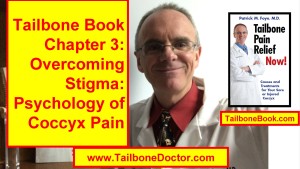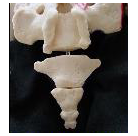Tailbone Book, Chapter 3, STIGMA and PSYCHOLOGY of Tailbone Pain, Coccyx Pain
- This is the next in a series of videos that gives highlights from the chapters of Dr. Foye’s book, “Tailbone Pain Relief Now!”
The actual VIDEO is at the bottom of this page.
Here is the TEXT from the video:
- Hi. I’m Dr. Patrick Foye, M.D., Director of the Coccyx Pain Center or Tailbone Pain Center here in New Jersey, United States, online at www.TailboneDoctor.com.
- This is the next in a series of videos just going chapter by chapter and giving you a glimpse of the information within the different chapters in my book “Tailbone Pain Relief Now!”
- In this video, we’ll cover briefly some of the information in Chapter number three, which is overcoming stigma and talking about the psychology of tailbone pain.
- And the general point for this chapter is that unfortunately coccydynia, or coccyx pain, tailbone pain, is for some reason considered a taboo topic that a lot of people don’t want to talk about.
- Or they don’t mention it, or they feel embarrassed about it.
- So unlike if somebody injured their shoulder or their knee or their low back (in the lumbar spine up near the belt line)…
- Lots of people would feel comfortable telling their friends family co-worker, “Hey, I injured my shoulder… or my knee… or what have you…”
- But for the tailbone or coccyx, it’s an area that people feel less comfortable sometimes talking about.
- And there’s a certain amount of stigma just because it’s a very private area.
- It’s an area that people don’t talk about in public… over a public dinner you wouldn’t hear most people talking about their coccyx or tailbone.
- And that’s unfortunate because lots of people suffer with pain without knowing that that’s their problem because they don’t get the feedback and discussion from other people the way they would if it was a problem at their shoulder or their knee.
- And, also, they may not discuss it with their physician.
- Their physician may not know the pain that they’re suffering with
- Or the physician may not ask the appropriate questions to find out that the pain is down at the tailbone and not at the lower back lumbar area (up near the belt line, which is more common).
- So, doctors will assume that that’s where your pain is as well.
- There’s a there’s a section in here that says sort of “What’s funny about tailbone pain?” which is just kind of making the point that… to a late-night talk-show comedian if a politician or celebrity injured their coccyx it would seem like something funny to joke about.
- But for people that are suffering with tailbone pain it’s obviously not funny at all.
- It actually can be a severe source of pain and suffering and can really be life-altering in a in a very negative way.
- So, there is a section here that talks about depression and anxiety in patients with coccyx pain.
- True for patients with chronic pain in general: when you live your life day-to-day having pain multiple times a day or throughout the day, day after day, week after week, month after month, year after year… it can be depressing and it can cause anxiety.
- And people can have their life start to revolve around the pain syndrome… and where can I sit without pain… and do I have my cushion with me… and can I go to that family social event when it’s a significant drive from here and the pain and the drive or the commute is painful and sitting for the event will be painful.
- So all of those things really become important.
- And it becomes important that when talking with or evaluating patients with tailbone pain that of course we do that with compassion and understanding and try to really appreciate that although the tailbone itself is a very very small bone (or series of bones, down at the lower tip of the of spine) the coccyx really can cause very severe pain and suffering and disability.
- So that’s certainly something to keep in mind.
- Tailbone pain itself can be can be certainly very frustrating for patients.
- And it’s important that not only their doctors be aware of that but that their family members be aware of that and appreciate that as well.
- By the way, as far as the doctors… there is a section here about bias from doctors and I can tell you even as a physician running at Coccyx Pain Center… I can tell you there’s bias from doctors who say, “Really, why would you want to keep treat those kinds of patients?” and really dismissive and non-compassionate comments that that are unfortunately all too common within the medical community.
- So really what you want to do is you want to find a doctor who will listen to you, who is understanding, who will take your symptoms seriously, so that they can do the appropriate diagnostic testing and the appropriate workup for you.
- There are lots of doctors who have told their patients, “Oh, well, tailbone pain… tailbone pain is not really a problem, or it’s not that serious. It’s just a little bone. Or maybe it’s all in your head.” or those kinds of dismissive comments that they typically would not make if you were having pain in your thumb, or your shoulder, or your knee, etc.
- So that becomes important to find a health care professional that works with you.
- So that’s kind of just a general glimpse of some of the things within Chapter 3 of the book.
- For a full copy of the book, the easiest way to get that is to go to www.TailboneBook.com
- And you can get a copy of the book.
- There will have all the links to the appropriate pages depending what country you’re in… whether it’s through Amazon, whether it’s the printed paperback copy of the book which is 272 pages or to get the electronic copy of the book.
- The e-book you can access from anywhere worldwide.
- You can get that and read it. You do not need a special ebook reading device or anything like that.
- So, again, go to www.TailboneBook.com
- To find me online, or to come for evaluation here, you can certainly find me at www.TailboneDoctor.com
- And post your comments down below, regarding this topic: about stigma and the psychology of tailbone pain, or comments that you may have had from doctors or friends or family.
- I think that that would be important for others to read and chime in on as well.
- Because it’s very very common that people have those kinds of stories, unfortunately.
- So, anyway, that’s Chapter Three from the book.
- I hope that’s helpful for you.
- Post your comments down below.
- Bye, bye.
Here is the actual VIDEO:
Here is the screenshot thumbnail image for the video:

Chapter 3 of Tailbone Pain Book: Stigma, Psychology, Emotional Stress, Depression, Anxiety, associated with Coccyx Pain. Tailbone Pain
To get your copy of the book “Tailbone Pain Relief Now!” go to: www.TailboneBook.com
For more information on coccyx pain, or to be evaluated at Dr. Foye’s Tailbone Pain Center in the United States, go to: www.TailboneDoctor.com
Latest posts by Patrick Foye, M.D. (see all)
- Coccygectomy: Expected Recovery and Return to Work after surgery for coccyx pain, tailbone pain. - November 28, 2023
- PRP Platelet Rich Plasma or Prolotherapy for Tailbone Pain, Coccyx Pain - October 25, 2023
- Reasons for Normal X-rays and MRI Despite Tailbone Pain, Coccyx Pain - October 3, 2023

